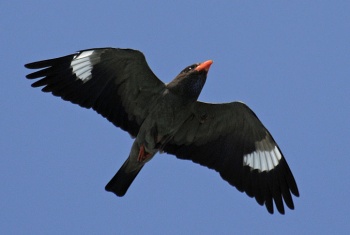(Imp sizes. Some extra info. Video link) |
(References updated) |
||
| Line 29: | Line 29: | ||
Particularly favours tall dead trees on which it often perches for long periods. Does not drop to the ground to catch prey, preferring to catch winged insects on aerial sallies. Prey items consists of a variety of beetles, crickets and mantises. | Particularly favours tall dead trees on which it often perches for long periods. Does not drop to the ground to catch prey, preferring to catch winged insects on aerial sallies. Prey items consists of a variety of beetles, crickets and mantises. | ||
==References== | ==References== | ||
| − | #{{Ref- | + | #{{Ref-Clements6thAug17}}#Handbook of the Birds of the World Alive (retrieved March 2017) |
{{ref}} | {{ref}} | ||
==External Links== | ==External Links== | ||
Revision as of 00:43, 14 January 2018
Alternative names: Eastern Broad-billed Roller; Oriental Dollarbird
- Eurystomus orientalis
Identification
27–32 cm (10½-12½ in)
Red bill with glossy dark blue-green plumage diagnostic. Appears black in poor light. Broad silvery white patch on base of primaries conspicuous only in flight(thus named Dollarbird).
Distribution
The Indian subcontinent,temperate eastern Russia, China, and Japan through South-East Asia to Australia and the Solomon Islands; northern and southern-most populations migrate to tropical latitudes during winter.
Taxonomy
Purple Roller, Eurystomus azureus was previously considered to be one additional subspecies of the Dollarbird.
Subspecies
There are eleven subspecies[1]:
- E. o. abundus: Himalayas to China, Manchuria and Korea; winters to Indonesia
- E. o. deignani: Northern Thailand; winters to Malaysia, Sumatra, Borneo and Java
- E. o. orientalis: Southern Himalayas to south-east Asia, Ryukyu Islands and Indonesian Archaepelago
- E. o. gigas: Southern Andaman Islands
- E. o. oberholseri: Simeulue Island (off Sumatra)
- E. o. connectens: Southern Sulawesi, Sula Islands and Lesser Sundas
- E. o. latouchei: North-eastern China
- E. o. waigiouensis: New Guinea, western Papuan islands, D'Entrecasteaux and Louisiade Archaepelago
- E. o. pacificus: Northern and eastern Australia; winters to New Guinea, southern Moluccas, adjacent islands
- E. o. crassirostris: Bismarck Archipelago
- E. o. solomonensis: Feni Island and Solomon Islands
Habitat
Mangroves, forests edges, beach scrub, plantation and open country.
Behaviour
Diet
Particularly favours tall dead trees on which it often perches for long periods. Does not drop to the ground to catch prey, preferring to catch winged insects on aerial sallies. Prey items consists of a variety of beetles, crickets and mantises.
References
- Clements, J. F., T. S. Schulenberg, M. J. Iliff, D. Roberson, T. A. Fredericks, B. L. Sullivan, and C. L. Wood. 2017. The eBird/Clements checklist of birds of the world: v2017, with updates to August 2017. Downloaded from http://www.birds.cornell.edu/clementschecklist/download/
- Handbook of the Birds of the World Alive (retrieved March 2017)
Recommended Citation
- BirdForum Opus contributors. (2025) Dollarbird. In: BirdForum, the forum for wild birds and birding. Retrieved 11 April 2025 from https://www.birdforum.net/opus/Dollarbird
External Links





